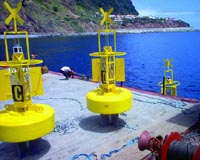 |
Everett WA (SPX) Jun 19, 2009 PowerSat has announced the filing of U.S. Provisional Patent No. 61/177,565 or "SPACE-BASED POWER SYSTEMS AND METHODS." The patent includes two technologies, BrightStar and Solar Powered Orbital Transfer (SPOT), which enable the reduction of launch and operation costs by roughly $1 billion for a 2,500 megawatt (MW) power station. "This patent filing is a watershed moment not only for PowerSat but for a renewables industry that, until now, could neither compete economically nor generate power at the base load scale of oil or coal," said PowerSat CEO William Maness. "Today, the convergence of technology and energy demand, combined with the political will to wean us off of fossil fuels, enables space solar power (SSP) to fill a widening clean energy supply gap." SSP is a clean, viable solution to our world's growing energy problems. Not limited by weather or geography, SSP solves the intermittency problems of earth-based renewables by providing a reliable and flexible energy source that is available 24/7. The underlying technology components are proven and systems will be deployable within a decade. Solar energy is captured via solar power satellites (known as powersats) and transmitted wirelessly to receiving stations at various points around the globe. Thousands of megawatts can be harnessed and shifted between receiving stations thousands of miles from each other-all in a matter of seconds. PowerSat Corporation's first patented technology, BrightStar, allows individual powersats to form a wireless power transmission beam without being physically connected to each other. This "electronic coupling," conceptually similar to cloud computing, effectively eliminates the need to handle large (gigawatt) levels of power in a single spacecraft. Because of BrightStar, one transmission beam may now come from hundreds of smaller powersats. Another advantage of Brightstar is increased reliability. If any of the individual component satellites fail they can be easily replaced without significantly affecting the performance of the system, thus establishing much greater reliability. The other technology being patented by PowerSat, Solar Power Orbital Transfer (SPOT) propels a spacecraft to an optimal, Geosynchronous Earth Orbit (GEO) using electronic thrusters that are powered by the same solar array that is eventually used for wireless power transmission. Until now, all satellites have had to use chemical propulsion or a chemically fueled "space tug" to move from Low Earth Orbit (LEO), which is 300-1,000 miles in altitude to GEO, which is 22,236 miles in altitude. SPOT technology also decreases the weight of a powersat by 67%, dramatically reducing launch costs, and enabling PowerSat modules to fly on rockets to LEO, deploy their solar powered electronic thrusters and then fly themselves out to GEO. GEO, the orbit for most communications satellites, is optimal because it allows a powersat to harvest the sun's energy continuously. Share This Article With Planet Earth
Related Links PowerSat All About Solar Energy at SolarDaily.com
 US Coast Guard Stocks Up On Carmanah Solar-LED Marine Lanterns
US Coast Guard Stocks Up On Carmanah Solar-LED Marine LanternsVictoria, Canada (SPX) Jun 19, 2009 The United States Coast Guard (USCG) has placed an order for hundreds of solar-LED marine lanterns from Carmanah Technologies. Valued at approximately $600,000, this latest shipment of 701-5 and 704-5 lanterns will replace older incandescent lanterns throughout the region, while providing an additional level of safety and security for marine traffic and Gulf Coast communities during the ... read more |
|
| The content herein, unless otherwise known to be public domain, are Copyright 1995-2009 - SpaceDaily. AFP and UPI Wire Stories are copyright Agence France-Presse and United Press International. ESA Portal Reports are copyright European Space Agency. All NASA sourced material is public domain. Additional copyrights may apply in whole or part to other bona fide parties. Advertising does not imply endorsement,agreement or approval of any opinions, statements or information provided by SpaceDaily on any Web page published or hosted by SpaceDaily. Privacy Statement |